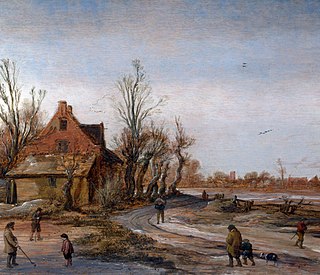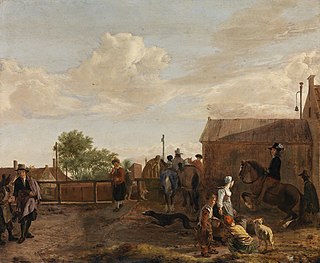
Delft is a city and municipality in the province of South Holland, Netherlands. It is located between Rotterdam, to the southeast, and The Hague, to the northwest. Together with them, it is a part of both the Rotterdam–The Hague metropolitan area and the Randstad.

CasparNetscher was a Dutch portrait and genre painter. He was a master in depicting oriental rugs, silk and brocade and introduced an international style to the Northern Netherlands.

Gerard ter Borch, also known as Gerard Terburg, was a Dutch Golden Age painter mainly of genre subjects. He influenced his fellow Dutch painters Gabriel Metsu, Gerrit Dou, Eglon van der Neer and Johannes Vermeer. According to Arthur K. Wheelock Jr., Ter Borch "established a new framework for subject matter, taking people into the sanctum of the home", showing the figures' uncertainties and expertly hinting at their inner lives. His influence as a painter, however, was later surpassed by Vermeer.

Frans van Mieris the Elder, was a Dutch Golden Age genre and portrait painter. The leading member of a Leiden family of painters, his sons Jan (1660–1690) and Willem (1662–1747) and his grandson Frans van Mieris the Younger (1689–1763) were also accomplished genre painters.

Adriaen Pietersz van de Venne, was a versatile Dutch Golden Age painter of allegories, genre subjects, and portraits, as well as a miniaturist, book illustrator, designer of political satires, and versifier.

Michiel Janszoonvan Mierevelt was a Dutch painter and draftsman of the Dutch Golden Age.

Hendrick Jansz ter Brugghen was a Dutch painter of genre scenes and religious subjects. He was one of the Dutch followers of Caravaggio – the so-called Utrecht Caravaggisti. Along with Gerrit van Hondhorst and Dirck van Baburen, Ter Brugghen was one of the most important Dutch painters to have been influenced by Caravaggio.

Esaias van de Velde was a Dutch landscape painter.

Dutch Golden Age painting is the painting of the Dutch Golden Age, a period in Dutch history roughly spanning the 17th century, during and after the later part of the Eighty Years' War (1568–1648) for Dutch independence.

Hendrik Martenszoon Sorgh was a Dutch Golden Age painter of genre works.

Jan van de Velde the younger was a Dutch Golden Age painter and engraver of animal, landscape and still-life subjects. He was the son of Jan van de Velde the Elder and the father of the still life painter Jan Jansz van de Velde.

Pieter Jansz van Asch was a Dutch Golden Age painter.

Ludolf de Jongh or Ludolf Leendertsz. de Jongh was a Dutch painter, known for his genre scenes, hunting scenes, history paintings, landscapes, cityscapes and portraits. He was further a merchant, an officer in the civil guard of Rotterdam and a schout (sheriff) of Hillegersberg. He was in the 1650s the leading genre painter in Rotterdam whose work influenced artists such as Pieter de Hooch. He was active as a staffage painter and added the figures in the works of artists such as the church interior painter Anthonie de Lorme and the landscape painter Joris van der Haagen.

Carel van Savoyen or Carel van Savoy (1620/21–1665) was a Flemish painter, draughtsman and printmaker who was active in Antwerp and Amsterdam. He is mainly known for his history paintings and portraits but he also painted allegories and genre scenes.

Anthonie Palamedesz., also Antonie Palamedesz, birth name Antonius Stevens, was a Dutch portrait and genre painter. He is in particular known for his merry company paintings depicting elegant figures engaged in play, music and conversation as well as guardroom scenes showing soldiers in guardrooms. Like many Dutch painters of his time, he painted portraits and still lifes, including vanitas still lifes. He further painted the staffage in a few views of the interior of churches. He played a major role in the development of genre painting in Delft in the mid 17th century.
Willem Verschuring, was a Dutch Golden Age Painter, Mezzotinter and a Burgomaster. He was born to Hendrik Verschuring and Aertgen van der Ham.

Nicolaas Verkolje or Vercolje, was a Dutch painter and mezzotinter.
He specialized in history pieces and portraits in a classicistic style.

Willem Isaacsz van Swanenburg, was a Dutch Golden Age engraver and the youngest son of Isaac van Swanenburg. Isaac van Swanenburg raised three sons who all became artists. Isaac van Swanenburg was also an artist who painted, designed prints, and created stained glass windows. The subject matter of his art included Biblical scenes, genre scenes, and portraits. He was also an illustrator for many books during his time.

The Procuress is a 1656 oil-on-canvas painting by the then 24-year-old Johannes Vermeer. It can be seen in the Gemäldegalerie Alte Meister in Dresden. It is his first genre painting and shows a scene of contemporary life, an image of mercenary love perhaps in a brothel. It differs from his earlier biblical and mythological scenes. It is one of only three paintings Vermeer signed and dated. In 1696 the painting, being sold on an auction in Amsterdam, was named "A merry company in a room".
Reinier Boitet, was a Dutch publisher and writer who updated Dirk van Bleiswijk's History of Delft in 1729.























